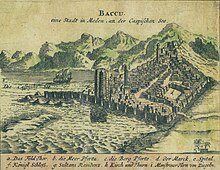İçəri Şəhər
| The walled old town of Baku with the Palace of the Shirvanshahs and the Maiden's Tower | |
|---|---|
|
UNESCO world heritage |
|

|
|
|
Palace of the Shirvanshahs |
|
| National territory: |
|
| Type: | Culture |
| Criteria : | (iv) |
| Surface: | 21.5 ha |
| Reference No .: | 959 |
| UNESCO region : | Europe and North America |
| History of enrollment | |
| Enrollment: | 2000 (session 24) |
| Red list : | 2003-2009 |
İçəri Şəhər ( Azerbaijani , Itschäri Schähär , inner city ) is the historical part of the inner city in the center of Baku , Azerbaijan , which is partially enclosed by a wall . İçəri Şəhər was included in the UNESCO World Heritage List in 2000 .
history

Baku was under the rule of the Shirvan Shahs in the Middle Ages and became its capital in the 12th century after Schemacha was destroyed by an earthquake. The ruler Abul Hidsha Manutschechra (1120–1149) built the city fortifications, of which individual sections date back to the 11th century. It was rebuilt and expanded several times until the 19th century. With two walls lying one behind the other, it enclosed an area of 21.5 hectares.
After the Russian conquest in 1806, the walls were reinforced again. Today the wall only exists on the north and west sides of the old town. The shape of the city was preserved well into the 19th century, most of the houses in the winding streets date from the time after the Russian conquest in 1783, and many monuments are much older.
Architectural monuments
In the center of the old town on the top of the hill is the Palace of the Shirvanshahs , a complex of medieval palaces, mausoleums and mosques . The most famous building is the Maiden Tower , built between the 6th and 12th centuries. There are various madrasahs , caravanserais and the Haji-Gaib- Hammam from the Safavid period . Two Zoroastrian fire temples were built in the 17th century. The Kasumbek mosque and the Kasumbek caravanserai date from the same period. The Mohammed mosque with the Synyk Kala minaret is the oldest of the numerous Muslim places of worship in the old town. Until it was demolished in 1992 in the course of the Nagorno-Karabakh conflict , there was an Armenian church in the shadow of the Maiden Tower , which was still under Persian rule around 1797 built Church of the Holy Mother of God .
2000 earthquake
In November 2000 an earthquake shook the city. In the years that followed, numerous historical buildings in the old town were demolished, in particular to make room for representatives of international companies to settle there. The number of residents decreased from 5,000 to 3,200. That is why the World Heritage Committee decided in 2003 to put İçəri Şəhər on the Red List of World Heritage in Danger.
The responsibilities for the protection and maintenance of the buildings as well as the fragmented urban planning, which prevent effective management, were also criticized. In 2005, therefore, a uniform administration was set up, which has since stopped construction activities. In 2009 the site was removed from the red list again and it was recognized that the buffer zone around the old town now offers better protection.
literature
- Kamil Fərhadoğlu: Bakı İçərişəhər . In: Bakı, Şərq-qərb Tarixi-arxeoloji tədqiqat II c. 2006 (Azerbaijani).
Web links
- Entry on the UNESCO World Heritage Center website ( English and French ).
- UNESCO / ICOMOS joint expert mission to the World Heritage site of the Walled City with the Shirvanshah's Palace and Maiden Tower (Azerbaijan), 4-10 March 2007, Baku (Word document)
- Baku. In the land of fire . From the documentary film series Treasures of the World
Individual evidence
- ↑ azerb.com About Baku (English)
- ↑ a b Ilona Turánsky. With photos by Károly Gink: Azerbaijan - palaces, towers, mosques . Translated from the Hungarian by Tilda and Paul Alpári. Corvina, Budapest 1980.
- ↑ Thomas de Waal: Black Garden - Armenia and Azerbaijan Through Peace and War. New York University Press, 2003. ISBN 0-8147-1944-9 , p. 103.
Coordinates: 40 ° 21 ′ 58 ″ N , 49 ° 50 ′ 6 ″ E


